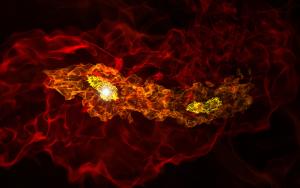Blog
First Star
I See Tonight
9 November 2019
 Michigan State University
Michigan State UniversityOur Sun is about five billion years old. It’s a difficult span of time to wrap our heads around, but the Sun is not particularly old for a star. We know of stars well more than twice that age. We also know that the Sun formed from the remnants of older, long-dead stars.
We know this because of a property of the Sun known as its metallicity. This is a measure of how much of the star is made of “metal,” which in astronomical terms means anything that is not hydrogen or helium. The metallicity of the Sun is about 0.02, which means about 2% of the Sun is made of metals.
The first elements in the universe were hydrogen and helium. There were traces of elements such as lithium, but all the heavier elements we see didn’t come from the big bang. They were mostly fused in the cores of stars that then exploded when they died, seeding the universe with all the carbon, nitrogen, oxygen and iron we see around us.
The metallicity of the Sun is pretty high for a star. That means the primordial cloud out of which the Sun formed was rich with metals. Metals produced in the cores of older dead stars. Those stars themselves were a product of even older stars.
The universe is only about 14 billion years old, so the cycle of stellar death and rebirth can’t have occurred endlessly. At some point in the early universe, the very first stars once lived. These stars would be comprised only of hydrogen and helium, since that all there was in the cosmos. But when did these first stars appear?
That’s a difficult question to answer. But a team has recently narrowed it down by looking at the spectra of a distant quasar.1 The light from this quasar, known as P183+05, has traveled for 13 billion years to reach us, and it gives us a glimpse of what the universe was like when it was only about 800 million years old.
When the team analyzed the spectra of this quasar, they found the fingerprints of metals such as carbon, oxygen, magnesium, and iron. Since these elements had to be produced within stars, it means the first generation of stars must have lived and died within the first 800 million years of the cosmos. The abundance of metals seen in the quasar is similar to that of intergalactic nebulae seen today. Perhaps multiple generations of stars appeared before the light of this quasar began its journey to us.
It’s not clear how that might have occurred. If true, early stars must have formed quickly and lived very short lives. But the first stars of the universe appeared earlier than we had thought.
Bañados, Eduardo, et al. “A Metal-poor Damped Lyα System at Redshift 6.4.” The Astrophysical Journal 885.1 (2019): 59. ↩︎